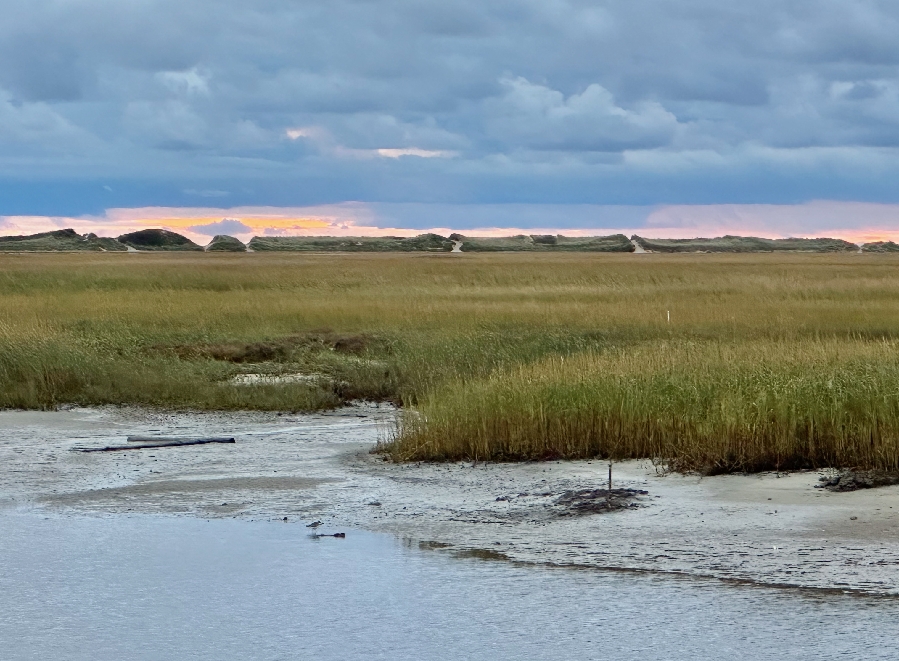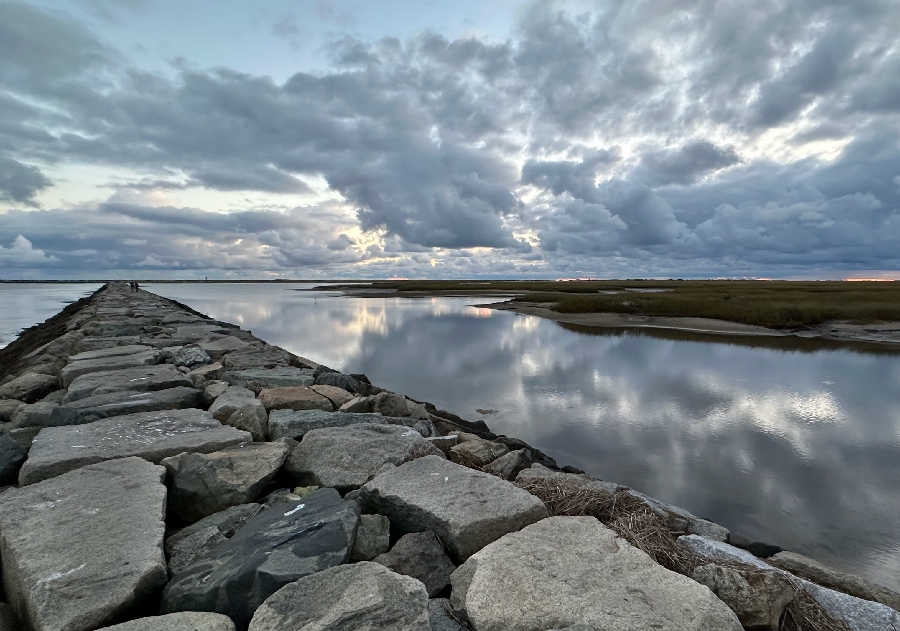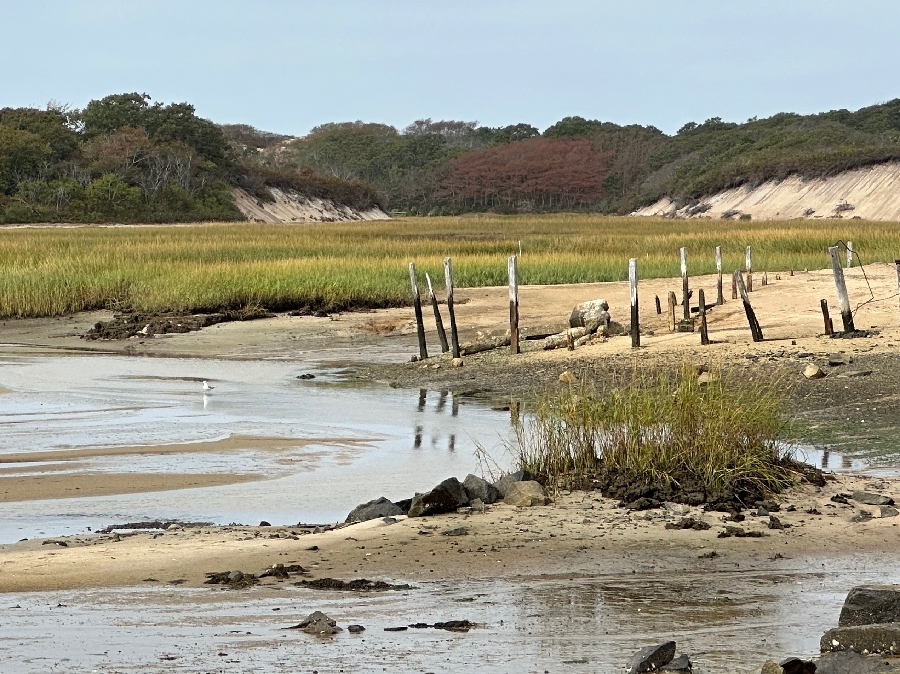PROVINCETOWN — Across the Outer Cape, an ever-growing explosion in the Sesarma crab population is causing salt marshes to rapidly retreat — but a new study suggests that adding sand might be the key to their restoration.

Sesarma crabs, also known as purple marsh crabs, are voracious grazers of saltmarsh grasses like the emerald-green Spartina that fills Provincetown’s West End marsh. They destroy the grasses by eating their roots from within tiny burrows, causing it to die back and exposing the thick layers of peat soil underneath, which then washes away.
Thanks to a combination of climate change and a decline in natural predators like blue crabs and cod, Sesarma populations have exploded across the Cape, according to the National Park Service. This has caused a rapid dieback at nearly every marsh from Boat Meadow Landing in Eastham to the West End marsh in Provincetown, said Cape Cod National Seashore plant biologist Stephen Smith. “They’re undoing thousands of years of marsh development,” he said.
While addressing the root causes of the crab explosion would require broader action, a study authored by Smith and published in the journal Wetlands Ecology and Management on March 17 found that adding a layer of sand to patches of denuded salt marsh could prevent crabs from burrowing there and facilitate rapid regrowth of marsh grasses.

This research holds particular relevance for Provincetown, where the retreat of the West End marsh has revived a long-dormant effort to breach the Long Point Dike, more commonly called the West End breakwater. That effort began in 2006 as a habitat-restoration project focused on fisheries but was revived in 2021 as the collapse of the marsh became more evident.
While adding a break in the dike would bring predator fish back to the West End marsh, it is unclear how much that would affect the crabs, since other marshes that are exposed to the open ocean are also in rapid retreat.
Adding sediment might keep crab populations in check regardless of what happens at the breakwater, though the strategy could face other barriers related to permitting and the physical application of sand.
Sand Application
For his experiment, Smith established 34 one-square-meter plots at the Gut in Wellfleet Harbor in 2022 and 30 in the West End marsh in Provincetown in 2023 on the edge of the retreating marsh grass. He left half of them untouched and covered half of them with 25 centimeters, or about 10 inches, of sand. He then surveyed the plots regularly each summer to assess the density of crab burrows and changes in vegetation.
By 2024, there were about 20 burrows per plot at the Wellfleet sites that were treated with sand compared with about 80 per plot in the control group. In Provincetown, the difference was even more extreme, with fewer than 10 burrows per plot in the extra-sand plots versus 50 per plot in the control group.
The reduced crab activity translated directly to better marsh growth. By the end of the study, the sandy plots in both towns were 70 percent covered in marsh grass, while the control plots in both towns were only 30 percent covered.
The added sand had a tendency to wash away, and Smith wrote that he put a few rocks around each plot to help limit this. “This is an artifact of having relatively small experimental plots with boundaries,” Smith wrote in the study. “If there were sand distributed over much larger areas, the proportion of edge to area would be dramatically reduced.”
He placed rocks around some of his control-group plots as well and observed that they didn’t appear to be a deterrent to crabs. “I watched Sesarma crabs walk across them,” he said. “There were no barriers.”
Smith said he was surprised by how effective the addition of sand was, even given that the plots were small-scale. The reason it works, he said, is that the crabs are unable to burrow in looser sand. Large volumes of sand are pushed into marshes in overwash events, he added, and this often creates patches that can resist invading marsh crabs for decades.

Smith said that National Seashore staff are planning larger-scale experiments with sediment placement as part of the Herring River Restoration Project.
The biggest hurdle with applying sand at scale is logistics, but applying large piles of sand to key places might allow the tides to do the work, he said. A project in the Netherlands used a “sand motor” to deliver sand that the tides then distributed, he added.
The Mass. Dept. of Environmental Protection published permitting rules for adding sand to salt marshes — a treatment the state calls “thin layer placement” — last December. The guidelines describe a multi-step process that can allow the addition of sand to help marshes adapt to sea level rise and more frequent storms.
Mark Faherty, science coordinator at Mass Audubon’s Wellfleet Bay Wildlife Sanctuary, said his organization is familiar with Smith’s study and is working in a similar direction. The sanctuary, which has also experienced marsh dieback due to Sesarma crabs, has received a grant to restore its marsh via sediment application and other techniques.
Because it can mitigate the effects of sea level rise by raising the marsh’s elevation and also prevent overgrazing by purple marsh crabs, Faherty said that adding sand “is like killing two crabs with one stone.”
Breaching the Breakwater
While Smith’s study is applicable all along the Outer Cape, it is especially noteworthy in Provincetown, where crab-driven dieback has revived a longstanding debate about breaching the breakwater.

Smith said that, based on his research, breaching the breakwater may not be as effective as sand application at protecting the marsh from Sesarma crabs.
“If you open that breakwater, it could have absolutely zero positive impact,” he said. While it wouldn’t hurt the marsh, the fact that so many Outer Cape marshes are also struggling with crab activity means connectivity to the open ocean is an incomplete answer.
The potential for a breach to cause channelized erosion of the shellfishing flats on both sides of the breakwater has also led to opposition. “Time and tide, they don’t stop,” said Michael Chute, who farms an aquaculture grant about a quarter-mile from the breakwater. “The effect of water pushing through one spot — it was bound to make some kind of impact on sand movement.”
Chute said he liked the idea of applying sand to the marsh. “A solution like this would make a smaller impact,” he said.
Dennis Minsky, a former chair of the conservation commission and an avid recreational clammer, agreed with Chute.
“I think it’s a good approach on about 10 levels,” Minsky said — naming the lower cost, decreased risk to shellfishing flats, and potential for reversal if problems were to arise. “Obviously the breakwater shouldn’t be there,” he said. “But it’s there and it’s been there, so if you change that now it opens up all sorts of challenges.”
Provincetown Shellfish Constable Stephen Wisbauer declined to comment on Smith’s study.
Conservation commission member Mark Adams said that there are other good reasons to breach the breakwater, including restoring ecological balance and increasing resilience. “The specifics with this habitat are that something is out of balance,” Adams said. “If we try to fix that artificially by adding sand, that’s going to be a really uncertain solution.”
Breaching the breakwater and adding sand might actually be needed, Adams said. “With these complex stresses, we might need this along with many other tools to keep habitats intact.”
Editor’s note: A photograph in an earlier version of this article, published in print on April 3, incorrectly identified a green crab as a Sesarma, or purple marsh crab.



